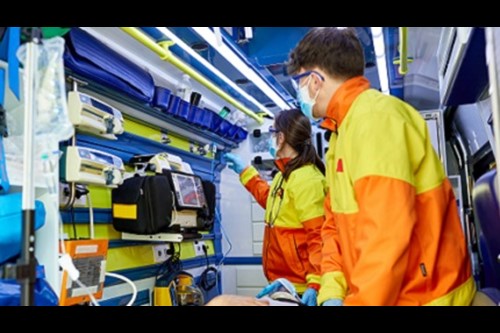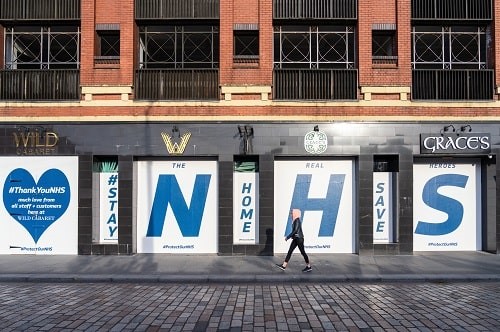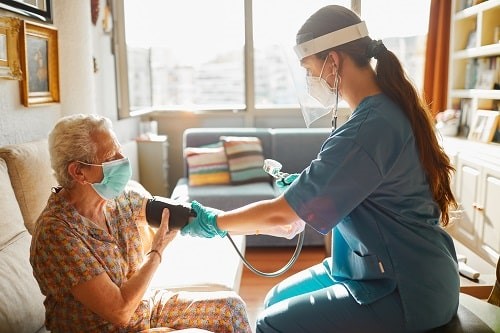For many of us the story of the pandemic has been shaped by numbers.
Features
The power of numbers in fighting a pandemic
There have been the awful, gasp and stop-in-your-tracks numbers – the more than 120,000 people who have died from Covid-19 in the UK, more than the total civilian casualties in the Second World War. The daily death toll that regularly surpassed 1,000 deaths at the pandemic’s height.
The millions who have been infected, and, of course the tens of thousands who continue to suffer with Long Covid. There is also age, expressed as a number, that is a highly significant indicator of people’s vulnerability to the worst effects of Covid-19.
For governments trying to get on top of a pandemic, numbers serve a number of purposes. They speak to the public about the seriousness of the situation and the need for them to follow the rules. They inform the government about progress of the pandemic and serve as a tool to evaluate the success of lockdown measures.
 When it comes to the workplace, what story have the numbers told? Are we clear about occupational exposure to Covid-19 and does it matter if we are not? Photograph: iStock
When it comes to the workplace, what story have the numbers told? Are we clear about occupational exposure to Covid-19 and does it matter if we are not? Photograph: iStock
We have seen how Covid-19 varies in its spread and transmission across the country and, again, by measuring new cases the government and authorities can make ground-level decisions based on evidence. The more real-time the evidence, the more effective will the intervention be.
Numbers in the workplace
But when it comes to the workplace, what story have the numbers told? Are we clear about occupational exposure to Covid-19 and does it matter if we are not? What is the true picture of infections and deaths from Covid at work? How may this be useful to guide the approaches to protect workers from harm?
HSE has been an important partner in government during the crisis and no-one can dispute that its experience and insights into workplace risk and ill health is second to none. However, have they been given enough support by central government to help ensure that workplace risks are being adequately managed to be as low as reasonably practicable?
Has our need for a functioning – if skeleton – economy been prioritised above the health of those people who had to go into the workplace? And when it comes to sectors like healthcare, is it not for individuals such as a 70-year-old doctor, to take the risk in order to serve the community? If we are simply ruled by numbers, is there not a danger that we undermine our public services? There are no easy answers but we can at least set out a path for a debate that is happening right now and that will continue long after 2021.
What do we know?
Homeworking data from the Office for National Statistics (ONS) shows that only 36 per cent of workers had been operating from their normal place of work in April 2020, the first full month of lockdown. In normal years this is more like 85-90 per cent. Latest data from the ONS reports that in the lockdown which began on 5 January 2021 this is more like 45 per cent of the workforce – an increase of 10 per cent. It seems clear therefore that the first lockdown caused more people to stop going into the workplace when compared to the current lockdown.
According to Imperial College London’s January 2021 report, this difference had an effect on infections. For Imperial College, with more people going into work in this latest lockdown, the fall in infections was slower when compared to the first lockdown in March 2020. In other words, with workplaces open and people either choosing or being told to go into the workplace, the result has been more infection – whether that’s exposure due to more movement on our trains and roads, or more people mixing in workspaces.
You might expect that the numbers recorded officially would reflect this. In one day in January 2021 there were 76,199 UK infections among the public. But according to Public Health England, workplace outbreaks never rose to more than 250 incidents each week (where two or more cases are linked to a particular workplace) in the peak. We have also been told that HSE has received reports under RIDDOR of 318 workers who have died from Covid-19 since the start of the pandemic. Yet, according to ONS, there were 7,961 deaths involving Covid in the working age population (aged 20 to 64 years) of England and Wales registered between 9 March and 28 December 2020.
Reporting Covid-19 at work
Some of this discrepancy might be due to employment – not everyone of working age was working – and to what counts as an occupational exposure, i.e how we can determine if an infection can be ‘reasonably’ attributed to work. We can see this in relation to RIDDOR.
Employers are legally bound to report any disease linked to an occupational exposure – Covid-19 or otherwise – to HSE under the Reporting of Injuries, Diseases and Dangerous Occurrences Regulations 2013 (RIDDOR). RIDDOR applies to all sectors and workplaces in Great Britain. As well as HSE, Public Health England monitors infection rates and the spread of infections both in community and workplace settings. In addition to that, the ONS captures all deaths involving coronavirus in working age people in England and Wales.
However, RIDDOR is a legal duty only where ‘there is reasonable evidence to suggest that the cause of the infection was more likely than not due to an occupational exposure to coronavirus at work’.
HSE goes on to point out that we must be aware that the difference in numbers between the ONS and RIDDOR reflects the different reporting criteria. “Fundamentally, the ONS and HSE numbers are measuring different things,” the spokesperson said. “The ONS measure captures all deaths involving coronavirus in the working age population of England and Wales. In contrast, RIDDOR regulations place a requirement on responsible persons in GB to report cases of Covid-19 deaths where there is reasonable evidence to suggest that it was caused by occupational exposure.”
 Photograph: iStock
Photograph: iStock
As an example, given healthcare workers are in direct contact with those suffering from Covid-19, it is unsurprising that there are so many healthcare workers in the RIDDOR data: the occupational link is easier to prove. RIDDOR tells us that 227 deaths were reported from healthcare settings between 10 April 2020 and 6 February 2021, with 121 deaths in ‘human health’ settings and 100 deaths in ‘residential care.’ Yet for a similar period (though only up to December 2020) ONS tells us that 469 deaths occurred in social care settings and 414 deaths in health care settings (including doctors, nurses, ambulance drivers, porters etc).
The difference is large and as HSE says may reflect the two approaches to measurement and what’s reportable. Yet should such a large difference cause us to pause and reflect? Is there a danger that we are underplaying the role of work in the pandemic? Could something else beyond ‘criteria’ be driving these differences?
Health versus safety
HSE and PHE both acknowledge significant under-reporting of Covid-19 in all settings, even by following the criteria. With RIDDOR, this is unsurprising and in common with many occupational health diseases – mesothelioma, asbestosis, HAVS. So, whereas with a safety incident, it’s clear that the worker who died after falling from a scaffold suffered a workplace accident, the same isn’t true for health.
 The difference between numbers of deaths reported by ONS and HSE in healthcare settings is large. Photograph: iStock
The difference between numbers of deaths reported by ONS and HSE in healthcare settings is large. Photograph: iStock
If I develop occupational lung disease, is that from smoking or from my employer failing to provide me PPE for silica dust? If I have Covid-19 and I am of working age, did I catch it from my journey into work, from a family member or from a colleague or customer? This uncertainty can be easily used by employers to justify non-reporting for reasons of loss of work, reputation or through fear of litigation.
Fear of litigation
In the case of Covid-19 in the workplace there are other issues that have fuelled under-reporting, says Mark Littlejohns, a health and safety consultant at Capital People Consultants who is based in Wales: “I think the general belief among organisations is if you report something that you’re setting yourself up for enforcement. The reality is there’s probably more of a penalty for not reporting.”
He adds that there’s also a lack of competence and understanding in a lot of organisations about what and how to report. “They think that if they do report they are opening themselves up to liability as they don’t understand the process and the concept of negligence. They can still be doing everything that is reasonable of them and have a Covid-19 case in their workplace.” Workers contracting Covid-19 is not necessarily an indication of poor risk-management. In fact, some lawyers do not like this idea of ‘Covid-security’ for this reason – it implies that employers should aim at 100 per cent safety which has always been contrary to the principles of good health and safety as practised in the UK.
Mark explains that he has come across organisations that have panicked and reported too assiduously and others that have reported nothing for fear of recrimination. One care firm he says, went from reporting every single case amounting to 40 in one care home, regardless of the occupational link, to reporting no cases at all.
It’s revealed a lack of understanding that’s probably always been there when it comes to health and reporting, and he says the systems are not at fault: “The process of reporting should be fairly straightforward in terms of RIDDOR and track and trace, but I think that what breaks down when it comes to reporting is getting to that stage. Many employers don’t understand what, who or how to report and that ties in with reporting generally in health and safety. That could be Covid, or it could be any general occupational diseases. We have evidence of massive under-reporting.”
Why it matters?
Why do we need to know how many employees are likely to have contracted Covid-19 through their work? According to Raymond Agius, Emeritus Professor of Occupational and Environmental Medicine at the University of Manchester, it is more about transparency on the issue of workplace risk, so as to take appropriate steps to protect workers.
A self-professed remobilised doctor, rejoining the ranks of academia after retirement to help with the Covid-19 effort, he has been dismayed to see work barely been mentioned in the ministerial TV briefings. “Never, as far as I recollect, in all the almost daily briefings has a government minister come on and said today we’re going to discuss work. There were plenty of discussions of school, but not workplaces. But workplaces are very important as loci for transmission of the virus.
"Care homes became ‘nurseries’ for the virus among staff as well as residents, retail, manufacturing and packing where you have workers at close quarters on packing lines, public transport, other public facing jobs and offices where people still have to go into work and yet they didn’t have adequate segregation or ventilation. All those were incubators and places of spread of the virus.”
Agius says data capture could have saved lives, for example, by using data on workplace infections and deaths to adjust risk management strategies.
“I know of cases of healthcare workers who had contracted Covid which a medical doctor had concluded was likely contracted at work. However, managers have said that the workers were wearing surgical masks as advised by Public Health England and they interpreted the HSE guidance as meaning that those cases were probably not caused by work and therefore did not report them through RIDDOR.”
He continues: “However, there is strong evidence that surgical masks might not be adequate to protect staff from infected patients on wards or in clinics. Failure to report those cases meant that opportunities for the HSE to investigate and to learn lessons to protect staff were being missed.”
For Agius the message has been to downplay the risks of viral aerosols and discourage reporting. “That is completely wrong, not only because others have said that a surgical mask is not adequate protection, but because these are exactly the cases that need to be investigated.” In March of this year a report commissioned by the Royal College of Nursing came out urging government to provide all healthcare staff – not just those surgeons with direct Covid-19 patient contact – with better respiratory protection.
HSE makes the point that the guidance (as of 23/03/21) requires the full assembly of PPE – not just masks – along with Covid-secure measures like social distancing, and a breach of any one of these could be grounds for reporting. But, as anyone knows from a risk management background, such measures are not 100 per cent foolproof and the question remains about still making efforts to establish attribution of the illness to work activities. Cases of work-related Covid deaths may be lost.
For Mark “people sometimes forget that the RIDDOR reporting process isn’t about prosecution or tarnishing someone’s reputation, setting wheels in motion for civil action. It’s about collecting statistics.” As long as we have the numbers, he suggests, we can in due course analyse and learn lessons.
Yet Alice Martin, writing for the Guardian on behalf of the Public Interest Research Centre, says companies should be required to disclose all cases and fatalities among its workforce, regardless of the occupational link. “Let’s not sweat about where cases were picked up – our authorities are too underfunded to adjudicate this in real time.” She says information could be used to draw comparisons between company statistics and sectoral and national averages.
All this information can help with enforcement priorities.
Future – what next?
One thing that the pandemic has taught us is that numbers do matter. Without them we would never have appreciated how dangerous Covid-19 is and we would have probably not followed the lockdown rules to the degree that we have. And we would not now be in the position we are to look back and analyse the pandemic and our response – including by employers, the regulators and government - without them. Though the debate is ongoing and it is too soon for conclusions, as we look back there are some questions that should be considered.
First, this question of the best way to collect workplace data on Covid-19 infections and deaths. Is the disparity between RIDDOR and ONS data on deaths just the result of the difference in what reports are required? As we saw, ONS says that in healthcare settings alone, 1,000 working age people died from Covid-19 compared to 227 through RIDDOR. Can we be sure that the majority of the ONS deaths are as a result from exposure outside of work? If that’s not credible, then isn’t there a danger that we miss the opportunities that RIDDOR provides?
Yet, as long as we have the data, isn’t it the case that the authorities can investigate and establish likely routes of transmission and learn those lessons once the urgency of the pandemic has subsided? There is a strong argument to be made that during a pandemic our need for our essential services, particularly the healthcare sectors, is too great.
Should the regulator be making more use of ONS data to direct its enforcement activity? Could reporting also be widened to consider other factors, not just a known exposure? For example, travelling to work, or contact with the public. Mark says this could be helpful: “I live in Cardiff, but when you see people travelling to work on public transport in London you have a considerably higher risk of contracting virus – a busy tube at 7.30 compared to my commute in Cardiff where I pass a couple of sheep. It would be interesting to see those sorts of things, those are the statistics we don’t have.”
Finally, to pick up on Professor Agius’s point, shouldn’t there have been more attention given to work in the government’s presentations to the public? Working people have died from Covid-19. Not all work that people have travelled into the workplace for is essential.
Should this have been made clearer by a transparent presentation of data, with the caveat that attribution is still in the process of being established? Isn’t it possible that our under-reporting of occupational infections and deaths has driven an under-appreciation of the dangers of going into the workplace? And has it driven an under-appreciation of the sacrifices that people have made? Behind every number is a life.
Covid-19 disease reports made to HSE and Local Authorities here
RIDDOR reporting of Covid-19, HSE's guidance here
Covid-19 in the workplace, a British Medical Journal article:
bit.ly/398Rrxa
FEATURES

Watercooler Event to hone in on eight trends in employee health and wellbeing
By Claire Farrow, Make a Difference Events & Media on 15 April 2024
The free-to-attend Water Cooler Event at ExCeL London on 23–24 April will see more than 6,000 workplace experts coming together to explore the latest thinking, solutions and best practice for supporting and boosting employee wellbeing, diversity and workplace culture.

Sedentary working and how to combat the ‘sitting disease’
By Gavin Bradley, Active Working on 05 April 2024
Prolonged and excessive sitting poses a major risk to our health, but the Get Britain Standing campaign and On Your Feet Britain Day on 25 April are a great way of encouraging workers to sit less and move more.

Company culture and wellbeing: a crucial link
By Bex Moorhouse, Invigorate Spaces on 05 April 2024
Investing in measures to support worker wellbeing will be ineffective unless the company culture genuinely incorporates values like teamwork, involvement, flexibility and innovation.



